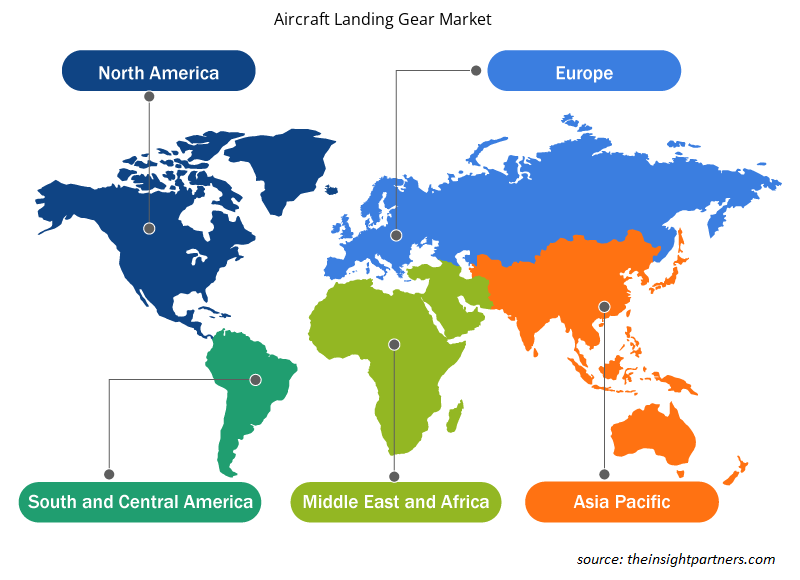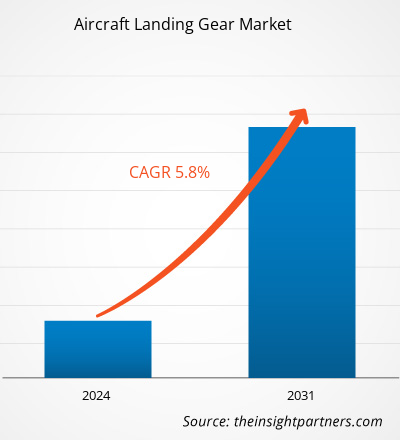飞机起落架市场规模预计将从 2023 年的 88.5 亿美元增至 2031 年的 138.8 亿美元。预计 2023-2031 年市场复合年增长率为 5.8%。
飞机起落架市场的主要趋势之一是售后市场的需求驱动,这是由于全球商用和民用飞机机型数量不断增加。一般来说,大修商用飞机起落架的使用寿命在 200 到 400 个着陆循环之间,具体取决于飞机型号的重量。此外,一些需要在维修期间进行 C/D 检查的老式飞机的增加是另一个可能推动 2023 年至 2031 年飞机起落架市场发展的主要因素。
飞机起落架市场分析
由于 COVID-19 疫情导致民航运营暂停,飞机起落架市场在 2020 财年受到重大负面影响后,目前正以正常增长率增长。然而,民航业在无限期后恢复运营,这也阻碍了对起落架 MRO 市场的需求。此外,飞机生产也已开始从暂停的生产设施中恢复,并见证了正的收入增长,这是推动飞机起落架安装增长的另一个主要因素。此外,全球航空客运量的增加是推动飞机起落架市场规模从改装用户扩大的主要次要因素之一。
飞机起落架市场概况
未来几年,飞机起落架市场可能会出现强劲增长。飞机起落架市场的增长归因于以下一些关键因素:
- 全球飞机产量和交付量不断上升
- 飞机MRO行业增长推动飞机零部件增长
- 不同地区飞机机队的增长情况
- 主要飞机原始设备制造商的订单积压情况
这些因素很可能对飞机起落架行业的积极增长产生重大影响。其他可能推动飞机起落架市场发展的主要因素包括民用直升机采购量的增加;低成本航空公司/低成本承运人 (LCA/LCC) 的引入推动飞机运营以满足不断增长的全球航空客运量和货运量;以及全球军费开支不断增加推动军用飞机和直升机采购合同数量的增加。
定制此报告以满足您的需求
您可以免费定制任何报告,包括本报告的部分内容、国家级分析、Excel 数据包,以及为初创企业和大学提供优惠和折扣
-
获取此报告的关键市场趋势。这个免费样品将包括数据分析,从市场趋势到估计和预测。
飞机起落架市场驱动因素和机遇
全球飞机交付量不断增长
飞机交付数量的增加是推动起落架市场增长的主要因素之一。例如,主要飞机巨头之一的空中客车 2023 年交付了约 735 架商用飞机,自 2022 年以来增长了 11%。此外,在同一时期,空中客车还获得了超过 2315 架商用飞机的总订单,其中包括 1,835 架 A320 系列和 300 架 A350 系列飞机型号。同样,另一家飞机巨头,即“波音”,在 2023 年向全球交付了 528 架商用飞机,而 2022 年交付了 480 架飞机。此类飞机交付在 2023 财年主要推动了飞机起落架市场的增长。
未来二十年预计交付的飞机可能提供未来机遇
未来二十年,商用飞机的交付数量预计将出现强劲增长。根据空客的全球市场预测,2023 年至 2042 年期间,商用飞机交付量将超过 40,800 架。同样,根据波音的商用飞机市场预测,2023 年至 2042 年期间将交付超过 42,590 架新型商用飞机。未来二十年,新型商用飞机的生产和交付量如此增长,也可能为 2024 年至 2031 年预测期内的市场供应商创造新的机会。
飞机起落架市场报告细分分析
有助于得出飞机起落架市场分析的关键部分是飞机类型、起落架布置、类型、最终用户和地理位置。
- 根据飞机类型,飞机起落架市场分为飞机和直升机。飞机部分在 2023 年占据了更大的市场份额。
- 根据齿轮排列,市场分为三轮车、双轮车和尾轮车。三轮车在 2023 年占据了最大的市场份额。
- 从类型上看,市场已分为主起落架和前起落架。主起落架部分在 2023 年占据市场主导地位。
- 从终端用户来看,市场已细分为商用和军用。2023 年,商用市场占据主导地位。
飞机起落架市场份额按地区分析
飞机起落架市场报告的地理范围主要分为五个地区:北美、欧洲、亚太、中东和非洲、南美。
2023 年,北美占据了飞机起落架市场的主导地位,而亚太地区在预测期内可能会出现显着增长。北美地区包括美国、加拿大和墨西哥。2023 年,美国占据了北美飞机起落架市场的主导地位。这主要是由于全国航空客运量和飞机机队规模的增加。例如,根据运输统计局 (BTS) 的分析,2022 年,美国航空公司运送的乘客比 2021 年增加了 1.94 亿人次,同比增长 30%。
飞机起落架市场新闻及最新发展
飞机起落架市场通过收集主要和次要研究后的定性和定量数据进行评估,其中包括重要的公司出版物、协会数据和数据库。以下是飞机起落架市场的发展和战略列表:
- 2023 年 10 月,赛峰起落架系统公司与航空公司 Wizz Air 签署了一份为期五年的合同,为其 A320 系列机队的 57 架飞机进行维护、维修和大修 (MRO) 操作。(来源:赛峰集团,新闻稿/公司网站/时事通讯)
- 2022 年 5 月,麦哲伦航空航天公司宣布已与赛峰起落架系统公司(“赛峰”)达成一项为期五年的协议,以制造复杂的机加工起落架部件。(来源:麦哲伦航空航天公司,新闻稿/公司网站/时事通讯)
飞机起落架市场区域洞察
Insight Partners 的分析师已详尽解释了预测期内影响飞机起落架市场的区域趋势和因素。本节还讨论了北美、欧洲、亚太地区、中东和非洲以及南美和中美洲的飞机起落架市场细分和地理位置。

- 获取飞机起落架市场的区域特定数据
飞机起落架市场报告范围
| 报告属性 | 细节 |
|---|---|
| 2023 年的市场规模 | 88.5亿美元 |
| 2031 年市场规模 | 138.8亿美元 |
| 全球复合年增长率(2023 - 2031) | 5.8% |
| 史料 | 2021-2022 |
| 预测期 | 2024-2031 |
| 涵盖的领域 |
按飞机类型
|
| 覆盖地区和国家 |
北美
|
| 市场领导者和主要公司简介 |
|
飞机起落架市场参与者密度:了解其对业务动态的影响
飞机起落架市场正在快速增长,这得益于最终用户需求的不断增长,这些需求源于消费者偏好的不断变化、技术进步以及对产品优势的认识不断提高等因素。随着需求的增加,企业正在扩大其产品范围,进行创新以满足消费者的需求,并利用新兴趋势,从而进一步推动市场增长。
市场参与者密度是指在特定市场或行业内运营的企业或公司的分布情况。它表明在给定市场空间中,相对于其规模或总市场价值,有多少竞争对手(市场参与者)存在。
在飞机起落架市场运营的主要公司有:
- 赛峰集团
- 利勃海尔集团
- Hroux-Devtek 公司
- 柯林斯航空航天
- 凯旋集团
- Circor 国际公司
免责声明:上面列出的公司没有按照任何特定顺序排列。

- 了解飞机起落架市场主要参与者概况
飞机起落架市场报告覆盖范围和交付成果
“飞机起落架市场规模和预测(2021-2031)”报告对以下领域进行了详细的市场分析:
- 范围内所有主要细分市场的全球、区域和国家层面的市场规模和预测
- 市场动态,如驱动因素、限制因素和关键机遇
- 未来主要趋势
- 详细的波特五力分析
- 全球和区域市场分析涵盖关键市场趋势、主要参与者、法规和最新市场发展
- 行业格局和竞争分析,涵盖市场集中度、热点图分析、知名参与者和最新发展
- 带有 SWOT 分析的详细公司简介
- 历史分析(2 年)、基准年、预测(7 年)及复合年增长率
- PEST和SWOT分析
- 市场规模、价值/数量 - 全球、区域、国家
- 行业和竞争格局
- Excel 数据集
近期报告
客户评价
购买理由
- 明智的决策
- 了解市场动态
- 竞争分析
- 客户洞察
- 市场预测
- 风险规避
- 战略规划
- 投资论证
- 识别新兴市场
- 优化营销策略
- 提升运营效率
- 顺应监管趋势























 获取免费样品 - 飞机起落架市场
获取免费样品 - 飞机起落架市场